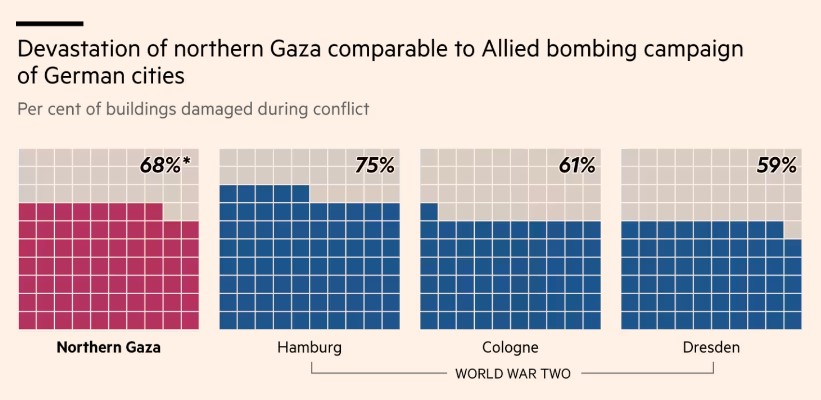By John Pickard
The savage bombing of Gaza, and the horrific death toll it has caused, has caused global outrage and even misgivings among those world leaders and government that have up to now supported Israel. Comparisons have even been made between the bloody vengeance wreaked on the population of Gaza by the Israeli government and the carpet bombing of German cities in the Second World War.
According to the Middle East Monitor, by the end of November, Israel had dropped more than 40,000 tonnes of bombs on Gaza in just over seven weeks. Benjamin Netanyahu has been quoted in the Israel Hayom newspaper, as saying, “We need three things from the US: munitions, munitions, and munitions,” and it is American tax dollars that are paying for much of the devastation of lives and buildings in Gaza.
The latest reports of the death toll make grim reading. Over 16,000 have been killed so far, two thirds of them woman and children. As many as 7,000 more are listed as missing and probably lie unrecovered under the thousands of tonnes of rubble spread all over the North. The total deaths in Gaza, near 23,000 are equivalent in terms of population, to two thirds of a million UK residents being killed, an appalling and outrageous number.
Whole neighbourhoods of Gaza have been reduced to debris. Over 60 per cent of buildings in Northern Gaza had been severely damaged. Hospitals, schools, infrastructure and residential buildings have all been targeted. The Israeli strategy is clearly to make Gaza uninhabitable for the population, should they even be allowed to stay in that narrow strip of land.
A macabre game of ‘battleships’
Public outrage over the bombing has forced US and European politicians to make a few hyprocritical noises about the high rate of civilian casualties. US secretary of state Antony Blinken, for example, last week warned Netanyahu “that the massive loss of civilian life and displacement of the scale we saw in northern Gaza [must] not be repeated in the south”. The Israeli ‘response’ has used gridlines to divide Central and Southern Gaza – its main target for bombing at the moment – into hundreds of segments and then expect the population to shuttle between one and another, as the Israelis urge them to ‘avoid’ the planned bombings.
As one UN official on the ground commented, it is like a macabre game of ‘battleships’. Most of the population have chosen, instead, to move away from built-up areas altogether. There are now, according to Al Jazeera, more than 1.8mn people crammed into an area no bigger than Heathrow airport.

An article in the Financial Times (December 6), drawing on the expertise of military specialists in bombing warfare, has drawn comparisons between the bombing of Gaza and the destruction of German cities in the Second World War. “Military analysts” the Financial Times reports, “say the destruction of northern Gaza in less than seven weeks has approached that caused by the years-long carpet-bombing of German cities during the second world war”.
The expert called upon by the Financial Times is Robert Pape, a US military historian. In his book, Bombing to Win: Air Power and Coercion in War, Pape points out that the conventional wisdom is that the overwhelming Israeli air power offers an effective and relatively cheap form of warfare. But rather than motivating citizens of a bombed nation to rise up against their government, Pape argues, massive bombing “often backfires, resulting in a citizenry that is more resilient and loyal”.
Up to a hundred thousand buildings left in ruins
Like Dresden, Hamburg and Cologne, “Gaza will also go down” Pape adds, “as a place name denoting one of history’s heaviest conventional bombing campaigns.” The Financial Times article draws on its experts to make comparisons with British/US bombing of Germany. “Across the whole of Gaza, between 82,600 and 105,300 buildings have been left in ruins…which counts buildings where at least half the structure was damaged. By contrast, over the space of two years, between 1943 and 1945, the Allied bombing of 61 major German cities razed an estimated 50 per cent of their urban areas”.
It is impossible to believe any of the propaganda that comes out of the Israeli Army press statements, although they are all repeated uncritically by the mainstream media. But the worst of all the lies is the claim that the IDF are trying to minimise ‘collateral’ casualties by the use of precision-guided bombs.
These minitions are a misnomer: there is no such thing as a ‘precision bomb’ and even if there were, the estimated collateral damage to the surrounding areas is measured in hundreds of feet, depending on the size of the bomb. The Israeli military are well aware of the damage and civilian deaths they are causing and it is ‘factored in’ and deemed acceptable, if it incapacitates or kills a few Hamas militants.
The Financial Times experts suggest that, in any case, Israel has deployed a large number of so-called ‘dumb bombs’ – without any guidance – including large, earth-shattering, 2,000 lbs bombs. The effect of these bigger bombs is utterly devastating. “Buildings pancake, their support disintegrates so they collapse in on themselves, and then there are the area effects — including the secondary fragmentation of cement, metal, peoples’ cell phones and everything else that flies out from the explosion at supersonic speeds,” one expert told the Financial Times. One does not need to be a military expert to imagine the effect of one of these bombs, ostensibly aimed at the Hamas tunnel network, on residential buidings nearby.
Deployment of 1,000 and 2,000 bombs
The international campaign organisation, Amnesty International, has called for a war crimes investigation over Israel’s deployment such heavy bombs. They have argued that there is evidence to show that 1,000lb and 2,000lb bombs were used to destroy homes in raids that killed 43 people.
The wave of revulsion against Israel’s treatment of Palestinians has shown no signs of abating. It is undermining support for Israel among many sections of the population where there was previously support – and this for a country that depends on international support and financial backing more than any other in the world. The US defence secretary Lloyd Austin, warned Israel last week that, while it may achieve a military victory, Israel risked a “strategic defeat”, unless it protected Palestinian civilian lives in Gaza.
The Palestinian casualties in Gaza, over two months, amounting to perhaps 23,000, compares with 12,000 civilian deaths recorded in the first nine months of the 2003 US/UK invasion of Iraq. “By any measure, Gaza is already a high civilian punishment campaign,” Robert Pape told the Financial Times, “it will go down in history as one of the heaviest ever undertaken with conventional weapons.”
This vicious and vengeful campaign is more than just a ‘risk’ for Israel. The apartheid state is facing an almost certain historic political and diplomatic defeat in the coming months, however it ‘succeeds’ with high explosives. The international support for Palestine will not go away and history will judge those Western and Israeli politicians who have blood and rubble on their hands.



